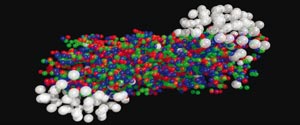The properties of quark–gluon plasma (QGP), where the quarks and gluons are no longer confined within hadrons, lead to intriguing effects that have already been studied in heavy-ion collisions at CERN’s Super Proton Synchrotron (SPS) and at the Relativistic Heavy Ion Collider (RHIC) at Brookhaven. However, the hot, dense medium produced momentarily in the collisions is a challenging environment for calculations in quantum chromodynamics (QCD), the theory that describes the strong interactions between the quarks and gluons. Though the medium is hot enough for the hadrons to “melt” into the QGP state, its temperature is still relatively low and the couplings between the quarks and gluons remain too strong to allow the use of perturbative QCD, which relies on the couplings being weak at high energies.
To get to grips with the strong couplings, a small group of theorists has taken inspiration from string theory. Hong Liu and Krishna Rajagopal of MIT and Urs Wiedemann of CERN make use of “gauge-gravity duality”, in which a gauge theory and a gravitational theory provide alternative descriptions of the same physical system. They map more complex calculations in a strongly coupled gauge theory onto a simpler problem in a dual gravitational string theory, and have looked at two intriguing effects observed in heavy-ion collisions – “jet quenching” and the suppression of the production of J/Ψ mesons.

Strictly speaking, they are not working directly with QCD as no one yet knows which string theory is dual to QCD. They work instead with a duality that works for a large class of gauge theories that behave similarly to QCD at high temperature. They then conjecture that the effects they find should also hold for QCD, and have made some predictions that can be tested at RHIC and at CERN’s LHC.
Jet quenching is one of the most dramatic pieces of evidence for the strong-coupling nature of the quark–gluon matter produced at RHIC. Here highly energetic quarks and gluons produced in the collisions interact with the matter so strongly that they are stopped within much less than a nuclear diameter, “quenching” the jet of hadrons that would normally materialize from the liberated quark or gluon. Previous attempts using perturbative techniques to calculate the parameter that characterizes this effect produced values an order of magnitude too small. Now, using the dual technique, Liu and colleagues have calculated a quenching parameter that is consistent with the data from RHIC, and had for the first time the right order of magnitude (Liu et al. 2006).
In a second calculation, the theorists have turned their attention to the problem of J/Ψ suppression. Screening effects in QGP are sufficient to reduce the attraction between a c and a c in the plasma to the extent that they are less likely to bind together to form a J/Ψ. This should lead to a reduction in the number of J/Ψ mesons produced in energetic heavy-ion collisions relative to proton–proton or proton–nucleus collisions. Previous calculations of this effect have depended on the non-perturbative approaches of lattice QCD. However, in lattice QCD the J/Ψ mesons are produced at rest, whereas in reality they will move at high velocities; from the viewpoint of the mesons, they will be in a “wind” of hot QGP.
With the aid of the dual approach, Liu and colleagues have calculated the screening effect of such a hot wind, and how it depends on velocity (Liu et al. 2007). Assuming that the same effect holds in QCD, the calculations indicate that additional suppression should occur for J/Ψ mesons with higher values of transverse momentum. This should be observable in future in high-luminosity runs at RHIC, and at the LHC, where the temperatures of the QGP may even be high enough to give suppression of the heavier Υ mesons.
Further reading
H Liu, K Rajagopal and U Wiedemann 2006 Phys. Rev. Lett. 97 182301.
H Liu, K Rajagopal and U Wiedemann 2007 Phys. Rev. Lett. 98 182301.







